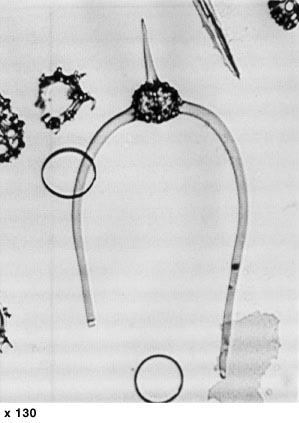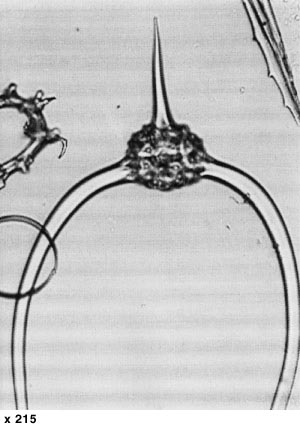 Dorcadospyris
forcipata (Haeckel)
Dorcadospyris
forcipata (Haeckel) Dorcadospyris
forcipata (Haeckel)
Dorcadospyris
forcipata (Haeckel)Dipodospyris forcipata Haeckel, 1887, p.1037, pl.85, fig.1
Dipodospyris forcipata Haeckel, Riedel, 1957, p.79, pl.1, fig.3
Dorcadospyris forcipata (Haeckel), Riedel and Sanfilippo, 1970, p.523, pl.15, fig.7
Shell subspherical to nut-shaped, tuberculate, with circular to subcircular pores separated by thick intervening bars. Horn thick, cylindrical, tapering to a point, approximately as long to 3 times as long as shell. Feet long, thick, cylindrical, almost semicircular or sometimes slightly recurved distally, with their convergent ends often separated, sometimes crossed (Riedel, 1957).
Length of apical horn usually 100-200 µm, of shell 75-85 µm, of feet (straight-line distance from origin to tip) 230-350 µm. Breadth of shell 95-115 µm (Riedel, 1957).
Breadth of lattice-shell 70-115 µm; length of feet 230-620 µm (Sanfilippo et al., 1985).
Dorcadospyris forcipata similar to D. praeforcipata, but without secondary feet, often seen on the latter form only as a ragged edge on the basal ring in poorly preserved specimens. Similar also to D. simplex, but with a strong apical horn and legs that often recurve distally (Moore, pers. comm., 1992).
Dorcadospyris forcipata differs from D. dentata and D. alata in lacking marginal spines on the feet, and from D. praeforcipata Moore (1971, p.738, pl.9, figs.4-7) in lacking secondary feet (Sanfilippo et al., 1985).
 VARIABILITY
VARIABILITYThis broadly defined species is characterized by two strong, curved primary feet and no secondary feet. A robust, cylindro-conical horn is usually present, but may be weakly developed or absent. The feet are commonly reflexed (lyre-shaped), but may also be simply semicircular (Sanfilippo et al., 1985).
This species is widely distributed in early Miocene samples in low and middle latitudes of all oceans. Its morphotypic first appearance lies within the Dorcadospyris ateuchus Zone and its morphotypic last appearance is approximately synchronous with the base of the Dorcadospyris alata Zone.
This species apparently evolved from D. ateuchus, and to D. dentata.
Additional illustrations can be found in Riedel, 1959, pl.1, figs.9-10; Riedel and Sanfilippo, 1971, pl.2C, figs.20-23, pl.3A, fig.8.
Holdsworth (1975) uses "D. forcipata Group" for this species, D. simplex, D. praeforcipata and intermediate forms.